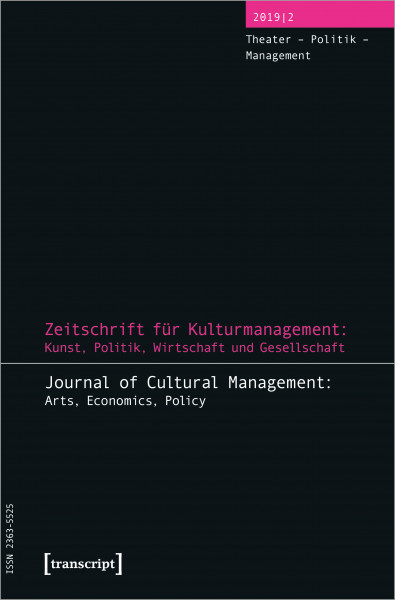Research Article
The audience of public and private theaters
Social characteristics, profiles of interest and ways of cultural participation
Abstract
Private theatres play a marginal role in public cultural debates, but they have a larger number of visits each year than publicly funded theatres (“Schauspielhaus”). In which ways the audiences differ in social characteristics, interests and cultural engagement is analyzed in the article, based on German audience and population surveys. It turns out that large overlaps exist between the audiences and that the differences in characteristics are gradual rather than basic. People who attend performances in private theatres are somewhat older and have a somewhat lower education than people who go to a “Schauspielhaus”. Moreover they are somewhat less interested in the high culture and less culturally engaged. Compared to the general population the theater audience as a whole is slightly above average in age. It is not known to which extent private theatre audiences have a greater share nowadays in theatre audiences than in earlier years. There are some indications that they might have undergone the same transformation in relationship to age as the publicly funded theatres: from an overrepresentation of the younger to an overrepresentation of the older ones.
Keywords
2019 (2)
Theatre – Politics – Management

Related Articles
Social Desirability’s Influence on Audience Research
Discerning and Reducing ItJournal of Cultural Management 2017 (2)
Research Article
Yearbook for Culture Management 2013
Research Article
Journal of Cultural Management 2017 (1)
Essay
Cultural Studies als Perspektive für Kulturmanagement
Yearbook for Culture Management 2010
Research Article
Neue Beteiligungsformen im Kulturmarketing
Yearbook for Culture Management 2012
Essay
Audience Development als Aufgabe von Kulturmanagementforschung
Yearbook for Culture Management 2012
Essay
© 2025, Journal of Cultural Management and Cultural Policy
Keywords
- Aesthetics
- Higher Education
- Cultural Diplomacy and Foreign Cultural Policy
- Occupation
- Career and Professional Role
- Audience Development
- Audience Studies and Visitor Studies
- Visitor Motivations
- Business
- Covid Pandemic
- Democracy
- Digitalization
- Diversity
- Third Sector
- Empirical Aesthetics
- Development
- Ethics
- Evaluation
- Field Theory
- Festival
- Film
- Federalism
- Community Arts
- Societal Change
- Ideology
- Staging
- Career
- Communication
- Concert
- Creative Industries
- Creativity
- Crisis
- Culture
- arts organizations, cultural organizations
- Cultural Participation
- Cultural Change
- Fincancing The Arts
- Cultural Promotion Law
- Cultural History
- Cultural Management
- Cultural Economy
- Cultural Organizations
- Art Education
- Cultural Policy
- Cultural Production
- Cultural Sociology
- Art Education
- Cultural Understanding
- Arts Administration
- Cultural Industry
- Cultural Sciences
- Art
- Art Field
- Arts Research
- Artists
- Artistic Research
- Artistic Reputation
- Arts Management
- Arts Organizations
- Art education
- Arts Marketing
- Arts Administration
- Curating
- Leadership
- Literature
- Advocacy
- Management
- Marketing
- Market
- Media
- Methods Development
- Mexico
- Monumentalizing
- Museum
- Music
- Non-Visitor Studies
- Opera
- Orchestra
- Organization
- Political Expression
- Post-truth Politics
- Professional Role
- Audience
- Audience Development
- Law
- Government
- Role
- Socially Engaged Art
- Social Cohesion
- Social Change
- Social Cohesion
- Non-visitor Socio-demographics
- Socioculture
- State
- Symbolic capital
- Dance
- Participatory Justice
- Theatre
- Theatre Governance
- Theory Development
- Tourism
- Transformation
- Survey
- Entrepreneurship
- Urbanism
- Civil Society


